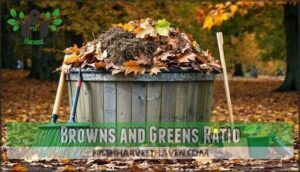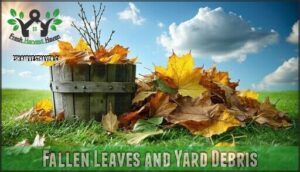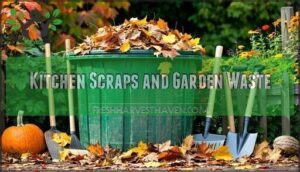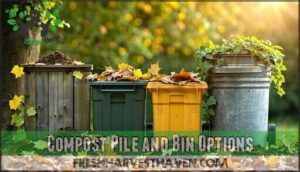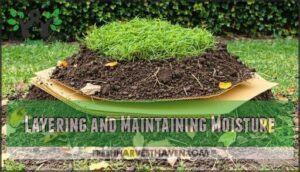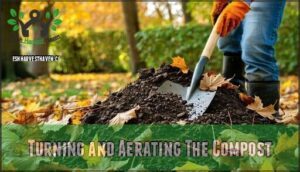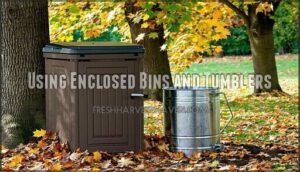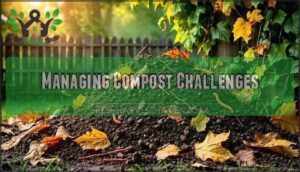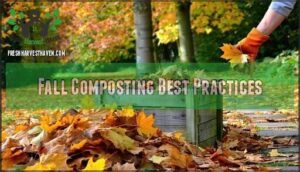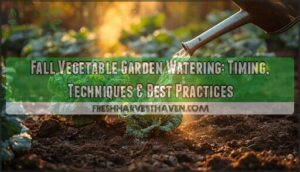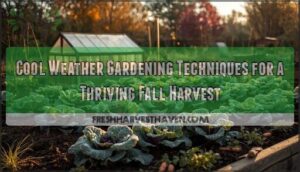This site is supported by our readers. We may earn a commission, at no cost to you, if you purchase through links.
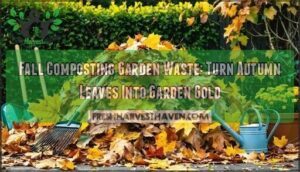
The key is balancing carbon-rich "browns" like dried leaves with nitrogen-rich "greens" such as vegetable scraps. Layer these materials, maintain moisture like a wrung-out sponge, and turn regularly for proper aeration.
Your pile will decompose slowly through winter, creating nutrient-dense compost by spring. Avoid diseased plants and weeds with seeds that’ll haunt your garden later. The secret lies in understanding ratios, moisture levels, and strategic material selection.
Table Of Contents
Key Takeaways
- Balance your browns and greens properly – Mix 3 parts carbon-rich materials (dried leaves, cardboard) with 1 part nitrogen-rich materials (kitchen scraps, grass clippings) to create the ideal 25-30:1 ratio for efficient decomposition.
- Maintain moisture like a wrung-out sponge – Keep your compost pile at 40-60% moisture content and turn it every 1-2 weeks to prevent foul odors and ensure proper aeration for beneficial microbes.
- Shred leaves to speed up the process – Breaking down materials increases surface area and cuts decomposition time by 50%, transforming your fall debris into usable compost faster.
- Avoid problematic materials – Skip diseased plants, weeds with seeds, and meat waste since they’ll survive standard composting temperatures and create problems in your finished compost.
Benefits of Fall Composting
Fall composting transforms your yard’s seasonal debris into nutrient-rich soil amendment that’ll supercharge your garden’s health.
You’ll reduce waste disposal costs while creating free fertilizer from materials like fallen leaves, spent plants, and kitchen scraps that would otherwise fill landfills, making it a great way to utilize seasonal debris.
Abundant Organic Material
Fall offers you nature’s treasure trove of compostable materials, transforming your yard waste into garden gold.
With abundant organic matter dropping right at your doorstep, you’ll discover three prime carbon sources for your compost piles:
- Fallen leaves – Nature’s perfect brown material for leaf decomposition
- Spent garden plants – Green materials rich in nitrogen
- Pruned branches – Structural elements that improve airflow
This seasonal bounty makes fall composting incredibly efficient and rewarding.
Soil Enrichment and Eco-Friendly Waste
Composting transforms your garden waste into nutrient-rich soil amendments while dramatically reducing landfill contributions.
This eco-friendly waste management approach creates a powerful cycle where fallen leaves and plant debris become tomorrow’s soil health foundation.
You’ll cut household waste by up to 30% annually while producing sustainable gardening solutions that enhance soil structure and water retention for healthier plants, which is an example of eco-friendly waste management and helps in dramatically reducing landfill contributions.
Preparation for Spring Gardening
Nothing beats having rich, nutrient-packed compost ready when spring arrives.
Fall composting rewards patience with spring’s perfect soil amendment.
Your fall composting efforts create the perfect soil preparation timeline, ensuring your garden planning includes that vital nutrient boost right when plants need it most.
Spring planting benefits from fall composting:
- Soil preparation happens naturally over winter months
- Compost timing aligns perfectly with growing season needs
- Garden planning becomes easier with guaranteed organic matter
- Nutrient boost provides essential minerals for healthy plant growth
- Compost piles transform garden waste into valuable soil amendments
Utilization of Kitchen Scraps
Your autumn canning sessions generate valuable food waste that shouldn’t hit the trash bin. Kitchen scraps from preserving activities—apple peels, vegetable trimmings, and coffee grounds—provide nitrogen-rich organic matter for your composting process.
This scrap management strategy transforms waste reduction into organic recycling, creating nutrient-dense kitchen compost. Garden waste combined with fall food scraps accelerates decomposition naturally.
Effective winter composting methods also rely on balancing green and brown materials to maintain a healthy compost pile.
Choosing Compost Materials
Success in fall composting starts with choosing the right materials to balance your pile’s carbon and nitrogen content.
You’ll want to collect roughly three parts brown materials (like fallen leaves, straw, and dead plants) for every one part green materials (such as grass clippings, vegetable scraps, and fresh plant trimmings).
Browns and Greens Ratio
Getting your Carbon Balance right matters more than you think. Browns and greens must work together like dance partners—too much of either creates problems.
Here’s what you need for perfect Compost Ratios:
- Brown Sources: Dried leaves, cardboard, and straw provide carbon-rich materials
- Green Materials: Kitchen scraps, grass clippings deliver nitrogen-rich materials
- Perfect Mix: Aim for 3 parts browns to 1 part greens by volume
- Balance Check: Proper green-to-brown ratio prevents odors and accelerates decomposition
Understanding winter composting methods is vital for maintaining a healthy compost pile year-round.
Fallen Leaves and Yard Debris
Your fall cleanup generates nature’s perfect compost ingredients.
Nature delivers a treasure trove of compostable materials right to your doorstep each fall.
Fallen leaves provide carbon-rich browns, while grass clippings and yard debris add nitrogen-rich greens.
This abundant yard waste creates balanced compost layers when properly managed.
Effective composting systems often rely on proper compost bin usage to facilitate decomposition.
| Brown Materials | Green Materials |
|---|---|
| Fallen leaves | Fresh grass clippings |
| Small twigs/branches | Spent flower heads |
| Dry plant stems | Vegetable plant remains |
| Shredded bark | Soft pruned branches |
Shredding leaves accelerates decomposition, transforming your leaf collection into valuable leaf mold for your compost pile.
Kitchen Scraps and Garden Waste
Kitchen scraps and garden waste become your composting powerhouse during fall’s harvest season.
You’ll transform food waste like vegetable peels, coffee grounds, and fruit scraps into nutrient-rich organic matter for your compost bins.
Garden clippings from spent flowers, plant trimmings, and seasonal cleanup provide excellent green materials, supporting waste reduction while fueling the composting process with diverse ingredients that accelerate decomposition and create balanced nutrition.
Avoiding Diseased or Insect-Infested Plants
Never compost diseased plants or pest-infested materials—they’ll turn your garden gold into a nightmare.
Plant disease pathogens like blight and mosaic viruses survive standard home composting temperatures, while pest eggs overwinter in finished compost.
Skip diseased leaves, weed seeds, and invasive plants entirely, as this is a crucial pathogen removal strategy, and your future vegetables will thank you for it, ensuring a healthier garden with less risk of mosaic viruses.
Composting Methods and Techniques
You’ll find several effective methods to transform your fall garden waste into nutrient-rich compost, from simple ground piles to sophisticated tumbling systems.
The key lies in choosing the right approach for your space, time commitment, and desired decomposition speed.
Compost Pile and Bin Options
Choosing the right setup transforms your composting experience from chaos to success.
You’ll need to decide between simple ground piles, contained bins, or rotating tumblers based on your space and commitment level.
Effective composting systems often rely on proper compost bin management to maintain healthy decomposition.
- Ground compost piles – The budget-friendly champion that costs nothing but requires more space and attention
- Enclosed compost bins – Your neat and tidy solution that keeps animals out while maintaining consistent moisture
- Compost tumblers – The speed demon that accelerates decomposition through easy turning and better aeration
- Wire cage systems – The DIY favorite that provides structure while allowing excellent airflow for healthy decomposition
Layering and Maintaining Moisture
Building your compost pile like a lasagna requires strategic compost layering and careful moisture control. You’ll want to alternate carbon-rich browns with nitrogen-rich greens, maintaining proper moisture levels throughout each layer.
This approach guarantees maximum carbon balance and accelerates your decomposition rate while promoting healthy soil aeration in your fall composting system.
| Layer Type | Materials |
|---|---|
| Brown (Carbon) | Dried leaves, straw, cardboard |
| Green (Nitrogen) | Grass clippings, vegetable scraps |
| Moisture Check | Should feel like wrung-out sponge |
Proper compost pile maintenance means keeping your pile moist but not waterlogged—aim for that perfect "wrung-out sponge" consistency that supports microbial activity without creating anaerobic conditions.
Turning and Aerating The Compost
Once you’ve layered your materials properly, regular compost turning becomes your secret weapon for faster decomposition.
Turning every 1-2 weeks maintains oxygen levels above 5-10%, supporting beneficial microbes that break down organic matter efficiently.
Here’s how proper aeration techniques transform your composting process:
- Temperature control – Maintains thermophilic temperatures (131-170°F) that kill weed seeds and pathogens
- Faster breakdown – Reduces total composting time by half compared to static piles
- Better texture – Creates uniform, clump-free finished compost through consistent mixing
- Odor prevention – Prevents anaerobic conditions that cause foul smells
- Nutrient retention – Increases available nitrogen by 25-30% through active microbial conversion
Regular pile management prevents matting and guarantees even moisture distribution throughout your compost.
Effective winter composting methods are vital for maintaining a healthy compost pile year-round.
Using Enclosed Bins and Tumblers
Enclosed systems like compost bins and tumblers transform your fall composting process into a streamlined operation.
These enclosed bins maintain consistent moisture levels while deterring unwanted pests from your decomposing leaves.
Tumbler designs allow you to rotate materials weekly, dramatically improving compost aeration and speeding decomposition.
Bin maintenance becomes effortless since these systems contain odors and create neater composting areas than traditional pile turners, making the process more efficient.
Managing Compost Challenges
Even experienced composters encounter problems that can slow down decomposition or create unpleasant conditions.
Common issues include foul odors, slow breakdown, pest problems, and materials that shouldn’t have been added to your pile, such as items that are not biodegradable.
Slow Decomposition and Foul Odor
When your compost pile moves slower than a snail race, you’re likely dealing with nitrogen deficiency or poor aeration.
Slow decomposition often signals an imbalanced carbon-to-nitrogen ratio, while foul odors indicate anaerobic conditions from excess moisture or compaction.
Common causes include:
- Insufficient green materials disrupting the composting process
- Poor aeration techniques creating oxygen-starved zones
- Excess moisture preventing proper carbon balance
- Oversized materials limiting surface area for breakdown, leading to slow decomposition and potentially causing foul odors.
Insufficient Heat and Diseased Plants
When your compost pile lacks heat management, add more nitrogen-rich greens or turn the pile to boost microbe balance.
Diseased materials require pathogen control—remove infected plants from your fall composting setup since standard compost turning won’t reach temperatures needed to kill pathogens.
Proper compost pile insulation and regular monitoring prevent these garden waste composting challenges from derailing your efforts.
Weeds With Seeds and Meat Waste
Weeds carrying mature seedheads threaten seed viability in your finished compost, potentially sprouting throughout your garden beds.
Composting temperature rarely reaches levels needed to kill stubborn seeds.
Meat, seafood, and pet waste create pathogen risks through anaerobic decomposition, attracting pests while producing foul odors.
Choose alternative disposal methods for these problematic materials to maintain healthy compost.
Effective winter composting methods, such as maintaining proper moisture levels, are essential for a successful composting process and to ensure proper moisture levels.
Fall Composting Best Practices
Success in fall composting depends on following proven techniques that maximize decomposition while preventing common problems. You’ll create nutrient-rich compost by spring when you apply these essential best practices consistently.
Selecting The Right Compost Location
Your compost location can make or break your pile’s success.
Choose wisely by considering these factors:
- Drainage issues – avoid low spots where water pools
- Sunlight exposure – partial shade prevents excessive drying
- Yard layout – accessible but away from windows
- Soil testing – level ground with good drainage
- Compost site distance from your garden waste sources
Position your compost bin where you’ll actually use it, not where it looks prettiest.
Maintaining Optimal Carbon-to-Nitrogen Ratio
Getting your Carbon Balance right transforms fallen leaves into gardening treasure.
The magic happens when you mix carbon-rich materials like dried leaves with nitrogen-rich materials such as kitchen scraps.
Your compost ingredients need that sweet spot of 25-30:1 carbon-to-nitrogen ratio to fuel Microbe Activity and create proper heat.
| Brown Materials (Carbon-Rich) | Green Waste (Nitrogen-Rich) |
|---|---|
| Dried leaves (60:1 ratio) | Fresh grass clippings (15:1) |
| Cardboard and paper (400:1) | Vegetable scraps (20:1) |
| Straw and wood chips (80:1) | Coffee grounds (20:1) |
Monitor your compost mix—if it’s too carbon-heavy, you’ll get slow decomposition.
Too much Nitrogen Levels create stinky, slimy conditions that’ll have your neighbors complaining.
Shredding Leaves and Monitoring Moisture
Proper leaf shredding accelerates decomposition rates by increasing surface area, breaking down materials three to four times faster than whole leaves.
You’ll want to maintain moisture content between 40-60% using the squeeze test—your compost should feel like a wrung-out sponge.
Regular compost turning redistributes moisture evenly while preventing anaerobic pockets that slow carbon balance and create odors.
Effective leaf management often involves using a leaf shredder tool to achieve the desired texture for composting.
Adding Finished Compost as a Starter
Kickstarting your fall composting with finished compost acts like a microbe boost for your pile.
You’re basically introducing beneficial bacteria and fungi that jumpstart decomposition.
Add two to three shovelfuls of mature compost or compost tea to new garden waste.
This compost starter accelerates nutrient cycling and transforms your autumn leaves into rich soil amendments faster than traditional methods alone.
Frequently Asked Questions (FAQs)
Should you put compost on your garden in the fall?
Like laying a warm blanket over sleeping plants, applying compost in fall nurtures your garden through winter’s dormancy.
You should absolutely spread compost now—it’ll slowly release nutrients, improve soil structure, and give your beds a head start for spring’s explosive growth.
Can I start composting in the fall?
You absolutely can start composting in fall.
It’s actually perfect timing since you’ll have abundant leaves and garden debris.
Cool weather slows decomposition but creates excellent conditions for building your pile over winter, which is a great opportunity for composting.
Do fall leaves make good compost?
Shredding leaves before composting cuts decomposition time by 50%.
Fall leaves excel as compost "browns," providing essential carbon for your pile.
They’re abundant, free, and balance nitrogen-rich "greens" perfectly when mixed properly.
When will my fall compost be ready?
Your fall compost will typically be ready in 6-12 months, depending on materials used, pile management, and weather conditions. Turn it regularly and maintain proper moisture for faster decomposition.
Can I compost during winter months?
Yes, you can compost during winter months, though the process slows considerably in cold temperatures.
Microbial activity nearly stops when temperatures drop below freezing, but decomposition resumes when conditions warm up again, which is a key aspect of the microbial process.
How do I protect compost from rain?
Like a protective umbrella shields from storms, cover your compost pile with a tarp, plywood, or bin lid. You’ll prevent waterlogging while maintaining proper moisture levels for decomposition.
What size should my compost pile be?
Your compost pile should be 3-4 feet wide and tall for ideal heat generation and decomposition.
This size maintains proper airflow while retaining enough mass to create the microbial activity needed for efficient breakdown.
Should I add lime to my compost?
Think of pH as your compost’s thermostat—most piles don’t need lime adjustments.
Your decomposing materials naturally balance acidity through microbial activity.
Only add lime if you’re composting highly acidic materials like pine needles.
Conclusion
Success in fall composting garden waste is like planting seeds for tomorrow’s harvest.
You’ve learned the essential balance of browns and greens, proper moisture management, and effective turning techniques.
Your autumn debris will slowly transform through winter’s cold months, creating nutrient-rich compost by spring.
Remember to maintain that vital 3:1 carbon-to-nitrogen ratio, keep materials consistently moist, and turn regularly for ideal decomposition.
With patience and proper technique, you’ll transform seasonal waste into garden gold.

